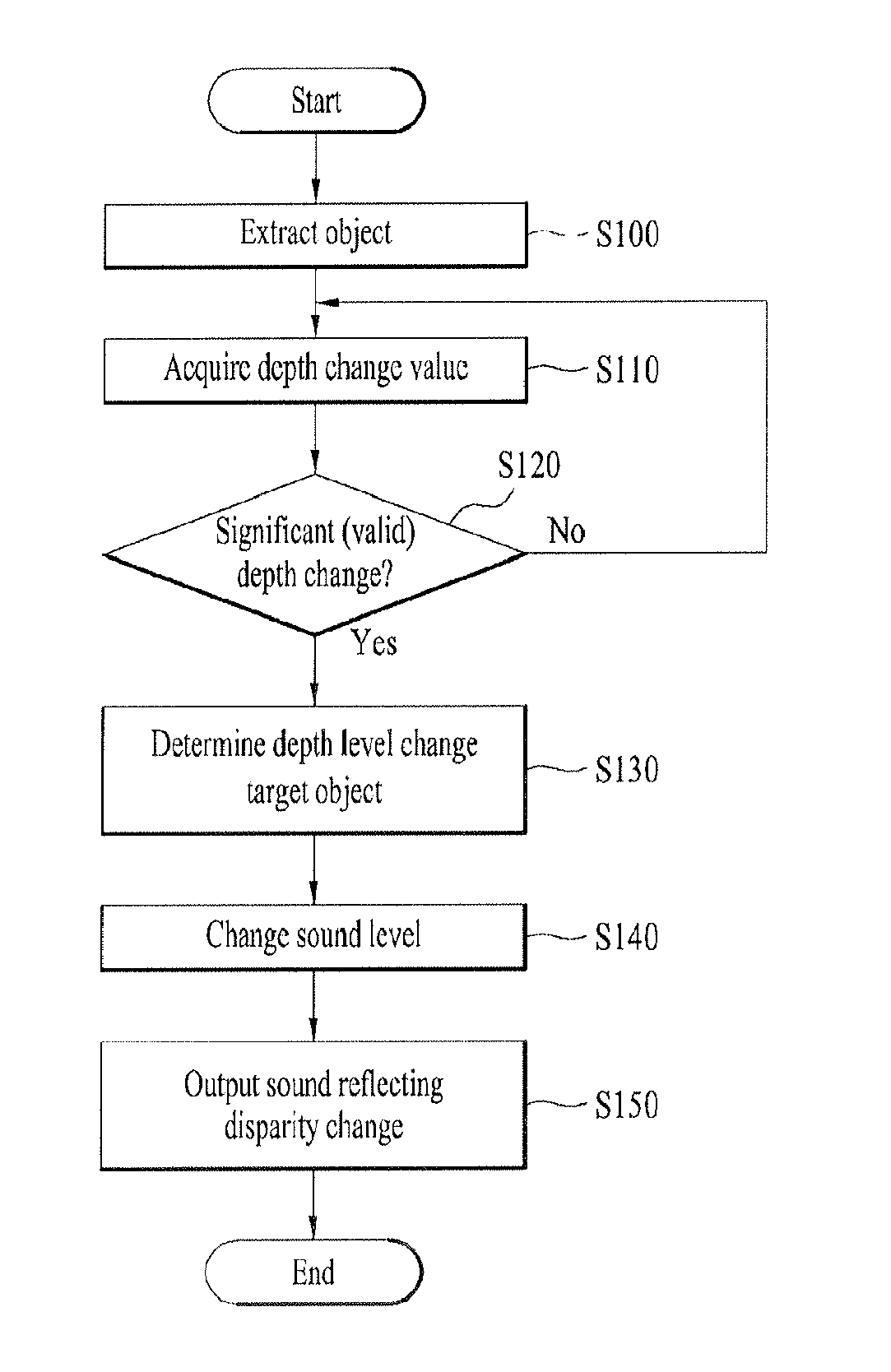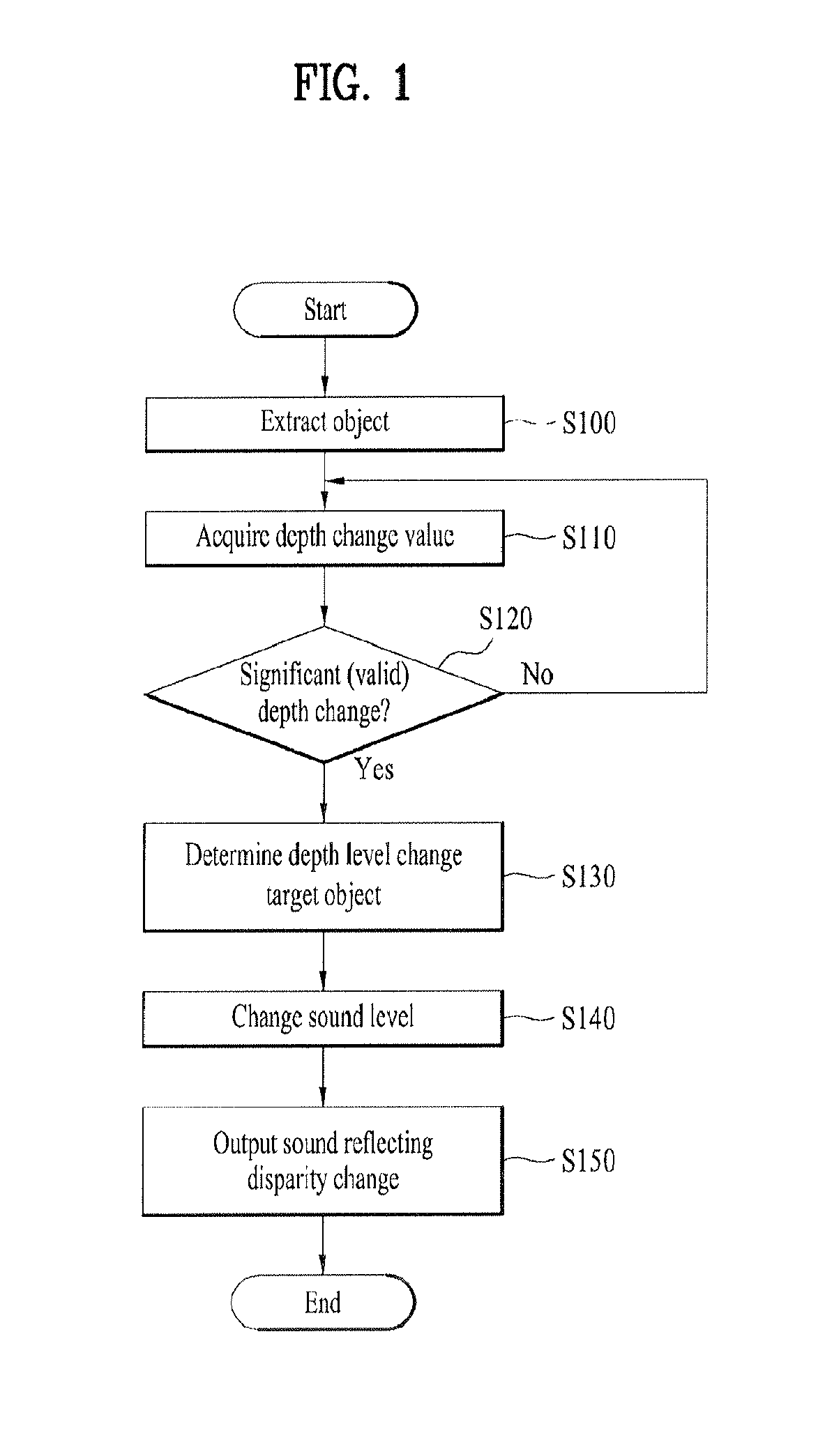Apparatus for controlling depth/distance of sound and method thereof
a technology of depth/distance and apparatus, applied in the field of apparatus for controlling depth/distance of sound and method thereof, can solve the problems of insufficient development of applied examples of extracting and using stereoscopic information such as depth information and the like from stereoscopic images, and the effect of a technology of outputting sound suitable for a stereoscopic effect of a stereoscopic image is limited to how, and achieves more sense of realism
- Summary
- Abstract
- Description
- Claims
- Application Information
AI Technical Summary
Benefits of technology
Problems solved by technology
Method used
Image
Examples
1st embodiment
1st Embodiment
[0052]FIG. 1 is a flowchart for a method of controlling a depth / distance of sound corresponding to a disparity of a stereoscopic image object according to a 1st embodiment of the present invention. In the following description, a method of controlling a depth of sound is explained in detail with reference to FIG. 1.
[0053]Referring to FIG. 1, an image inputted from an image input source, and more particularly, a non-disparity image such as a stereo 2-channel image, a 1-channel image, a time-of-flight camera image and the like is converted to a disparity image. In this case, the disparity image means an image including pixels each of which has a level value (or a color) varying in accordance with an extent of disparity between right and left images or a depth.
[0054]Subsequently, using the disparity image, at least one object existing in the image is extracted [S100]. In particular, a specific region to be analyzed is extracted by extracting an object from an image. Throu...
2nd embodiment
2nd Embodiment
[0102]In the following description, a method of controlling a depth / distance of sound according to a 2nd embodiment of the present invention is explained in detail with reference to FIGS. 11 to 14.
[0103]FIG. 11 is a flowchart for a method of controlling a depth / distance of sound according to a 2nd embodiment of the present invention.
[0104]Referring to FIG. 11, in a method of controlling a depth / distance of sound according to a 2nd embodiment of the present invention, first of all, a disparity histogram indicating a weight per pixel / region in accordance with a depth / disparity is acquired from a binocular disparity image [S710].
[0105]For instance, a disparity map is extracted from a binocular disparity image, the extracted disparity map is divided into a plurality of screen regions w1 to w3, as shown in FIG. 12, and weights are then applied to a plurality of the screen regions, respectively. On the assumption that a center region of the screen is more important than the ...
3rd embodiment
3rd Embodiment
[0110]In the following description, a method of controlling a depth / distance of sound according to a 3rd embodiment of the present invention is explained in detail with reference to FIGS. 15 to 18.
[0111]FIG. 15 is a flowchart for a method of controlling a depth / distance of sound according to a 3rd embodiment of the present invention.
[0112]Referring to FIG. 15, in a method of controlling a depth / distance of sound according to a 3rd embodiment of the present invention, first of all, a disparity histogram indicating a weight per pixel / region in accordance with a depth / disparity is acquired from a binocular disparity image [S810]. The disparity histogram acquiring method is identical to the former acquiring method of the 2nd embodiment of the present invention.
[0113]Subsequently, as shown in FIG. 14, a disparity histogram per level interval is found in a manner of dividing a horizontal axis of all histogram intervals, i.e., an axis of depth as many as the number of desired...
PUM
 Login to View More
Login to View More Abstract
Description
Claims
Application Information
 Login to View More
Login to View More - R&D
- Intellectual Property
- Life Sciences
- Materials
- Tech Scout
- Unparalleled Data Quality
- Higher Quality Content
- 60% Fewer Hallucinations
Browse by: Latest US Patents, China's latest patents, Technical Efficacy Thesaurus, Application Domain, Technology Topic, Popular Technical Reports.
© 2025 PatSnap. All rights reserved.Legal|Privacy policy|Modern Slavery Act Transparency Statement|Sitemap|About US| Contact US: help@patsnap.com



